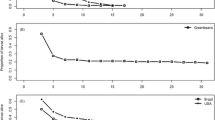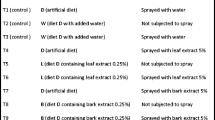Abstract
Several species of the flea beetles genus Longitarsus sequester pyrrolizidine alkaloids (PAs) from their host plants. Previous data demonstrated that PAs may be transferred from root-feeding larvae into the adult beetles. Here we compared the patterns and concentrations found in larvae and pupae of L. anchusae and L. echii with those of the roots of their respective hosts, Symphytum officinale and Echium vulgare (Boraginaceae). PA patterns and concentrations in the roots were complex and variable, whereas those in the larvae and pupae were simpler and more constant. In L. anchusae, intermedine and lycopsamine were the dominant PAs even if they could not be detected in the roots. In L. echii simpler, hydrolized PAs prevailed. Overall, the concentrations of total PAs of larvae and pupae were significantly higher than those of the roots the larvae had been feeding on. Larvae and pupae of both species also had considerably higher PA concentrations than determined previously for field collected beetles. Possibly the rather immobile juvenile stages enjoy a better protection by higher PA concentrations. On the other hand, we could not detect PAs in eggs of either species, indicating that transmission of appreciable amounts of PAs from mother to offspring does not occur.

Similar content being viewed by others
References
Dobler S, Haberer W, Witte L, Hartmann T (2000) Selective sequestration of pyrrolizidine alkaloids from diverse host plants by Longitarsus flea beetles (Coleoptera, Chrysomelidae). J Chem Ecol 26:1281–1298
El-Shazly A, Wink M (2014) Diversity of pyrrolizidine alkaloids in the Boraginaceae structures, distribution, and biological properties. Diversity 6:188–282. https://doi.org/10.3390/d6020188
Frölich C, Ober D, Hartmann T (2007) Tissue distribution, core biosynthesis and diversification of pyrrolizidine alkaloids of the lycopsamine type in three Boraginaceae species. Phytochemistry 68:1026–1037. https://doi.org/10.1016/j.phytochem.2007.01.002
Fu PP, Xia Q, Lin G, Chou MW (2004) Pyrrolizidine alkaloids--genotoxicity, metabolism enzymes, metabolic activation, and mechanisms. Drug Metab Rev 36:1–55. https://doi.org/10.1081/DMR-120028426
Haberer W, Dobler S (1999) Quantitative analysis of pyrrolizidine alkaloids sequestered from diverse host plants in Longitarsus flea beetles (Coleoptera, Chrysomelidae). Chemoecology 9:169–175
Haberer W, Witte L, Hartmann T, Dobler S (2002) Pyrrolizidine alkaloids in Pulmonaria obscura. Planta Med 68:480–482
Hartmann T (2004) Plant-derived secondary metabolites as defensive chemicals in herbivorous insects: a case study in chemical ecology. Planta 219:1–4. https://doi.org/10.1007/s00425-004-1249-y
Hartmann T, Witte L (1995) Chemistry, biology and chemoecology of the pyrrolizidine alkaloids. In: Pelletier SW (ed) Alkaloids: chemical and biological perspectives, vol 9. Pergamon Press, Oxford, pp 155–233
Narberhaus I, Papke U, Theuring C, Beuerle T, Hartmann T, Dobler S (2004a) Direct evidence for membrane transport of host-plant-derived pyrrolizidine alkaloid N-oxides in two leaf beetle genera. J Chem Ecol 30:2003–2022
Narberhaus I, Theuring C, Hartmann T, Dobler S (2004b) Longterm dynamics of pyrrolizidine alkaloid sequestration in Longitarsus leaf beetles (Coleoptera: Chrysomelidae, Alticinae). Chemoecology 14:17–23
Narberhaus I, Zintgraf V, Dobler S (2005) Pyrrolizidine alkaloids on three trophic levels - evidence for toxic and deterrent effects on phytophages and predators. Chemoecology 15:121–125
Trigo JR (2010) Effects of pyrrolizidine alkaloids through different trophic levels. Phytochem Rev 10:83–98. https://doi.org/10.1007/s11101-010-9191-z
Acknowledgments
We wish to thank Prof. K. Peschke at the University of Freiburg for letting us use his GC/MS laboratory and for encouraging advice and Dr. Till Beuerle for his help with the identification of the newly discovered simple PA in L. echii. Prof. T. Hartmann reviewed a previous version of the manuscript and gave helpful advice. We also thank Prof. Scott Kelley for critically reading the manuscript and improving the English. This work was supported by the Deutsche Forschungsgemeinschaft (DO527/2-2).
Author information
Authors and Affiliations
Corresponding author
Electronic Supplementary Material
ESM 1
(PDF 51.6 kb)
Rights and permissions
About this article
Cite this article
Dobler, S., Zintgraf, V., Haberer, W. et al. Ontogeny of Defensive Chemistry in Longitarsus Flea Beetles (Coleoptera, Chrysomelidae): More Protection for the Vulnerable Stages?. J Chem Ecol 45, 199–203 (2019). https://doi.org/10.1007/s10886-018-1010-9
Received:
Revised:
Accepted:
Published:
Issue Date:
DOI: https://doi.org/10.1007/s10886-018-1010-9




